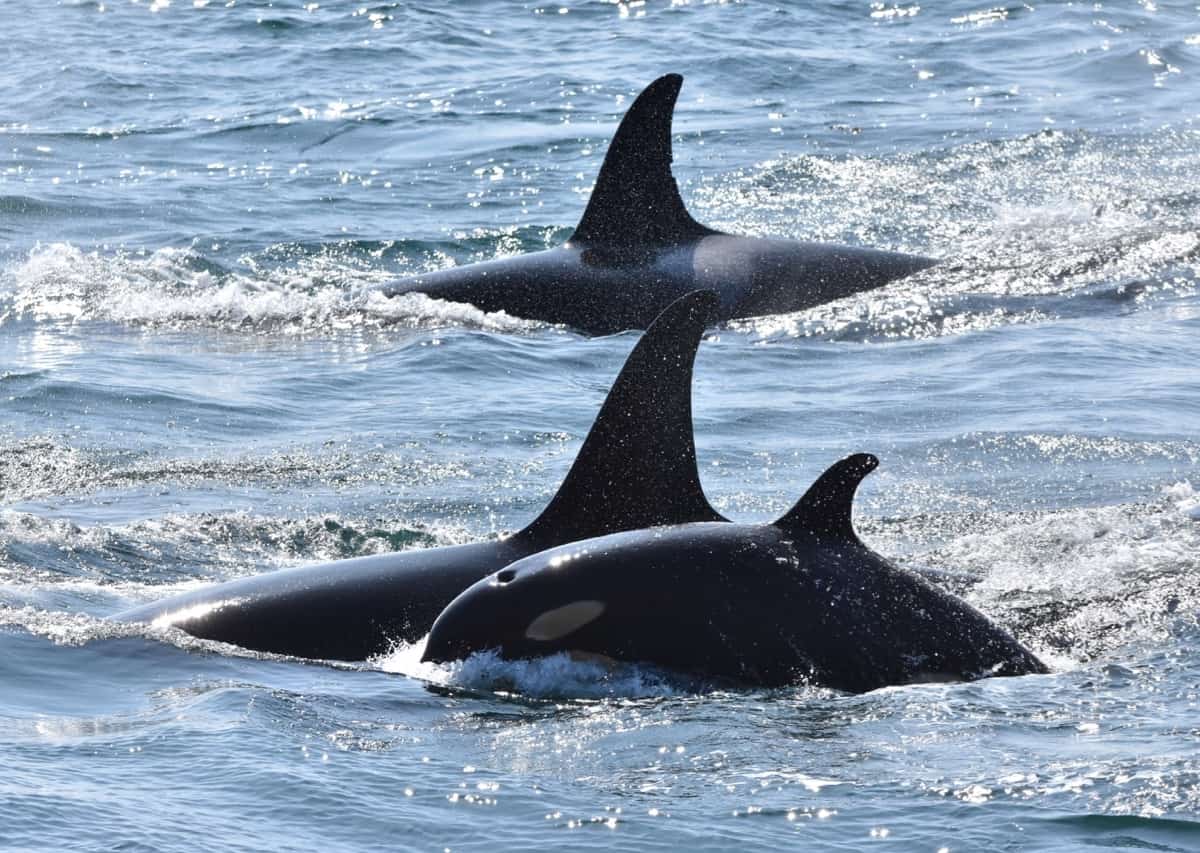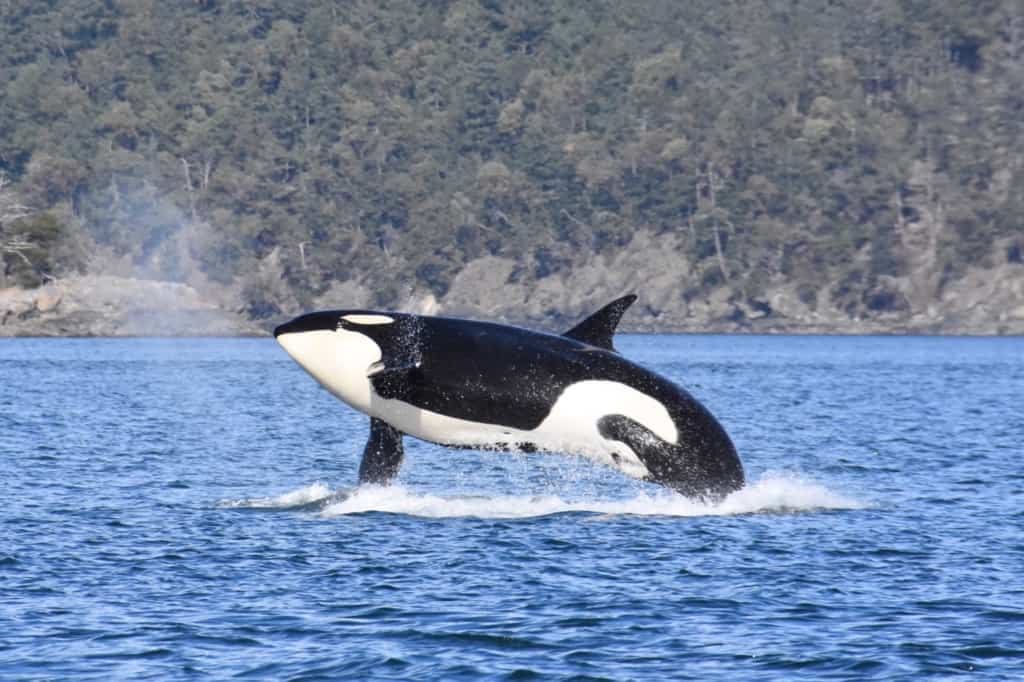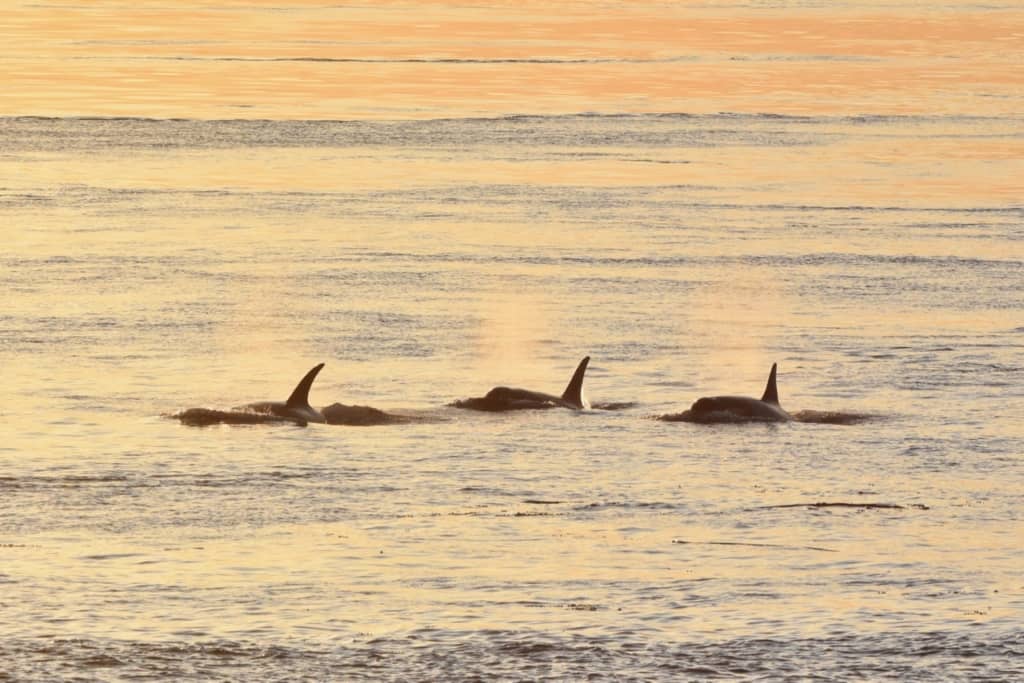
Endangered Orcas: An encounter on San Juan Island
It was two in the afternoon on a Friday in July and I had just gotten off work. I stopped in town for a sandwich, where I ran into Nancy, a whale-watch captain. She didn’t break her stride and said, “Js just got to Kellett when they flipped—it’s a west side shuffle kind of day!” This sentence might not mean much to the uninitiated, but it turned my whole afternoon around. J-Pod, the whales who had been heard on the Haro Strait hydrophones earlier in the day, had reached the north end of San Juan Island and then turned around. This put the pod back within range for me to see them from shore on the west side of San Juan Island.
Half an hour later, I had eaten my sandwich and was on the road leaving town. As I crested the hill in the Hannah Heights neighborhood, I got my first view of the water on the island’s west side, and looked left along the southern part of the shoreline to see if I could spot any whale-watching boats. A cluster of boats right off of False Bay all faced the same direction. That split-second look told me that the orcas were in a tight group heading north, right toward where I planned to be. I was the only car in the north pullout at Land Bank’s Westside Preserve. That would change as soon as the whales came into view, but for a moment I was the only one anticipating them.
It didn’t take long for the boats to come into view as they made their way around the point to the south. By the time the first whale approached my spot on the shoreline, other people had figured out that an encounter was imminent. I turned, surprised to see that thirty or forty people crowded the shoreline above me. Many eagerly pointed or took pictures as the first whale passed. The orca surfaced in front of me about two hundred yards offshore. The half moon–shaped notch in the dorsal fin told me it was J2 Granny, often in the lead when J-Pod travels through Haro Strait.

There were thirty Southern Residents present—all twenty-five members of J-Pod and five L-Pod whales that traveled with them that summer. The animals were all within about half a mile of each other, though somewhat spread out. Some were offshore, too far away to identify in the harsh afternoon sunlight, but after Granny another group swam in closer to the kelp. I wasn’t surprised to see J8 Spieden, J19 Shachi, and J41 Eclipse, three whales who often traveled close together and never roamed too far from Granny. Like Granny, the trio moved north at a good clip, but they had a little bit more of a playful attitude. Shachi tail slapped and her daughter Eclipse rolled onto her side at the surface, swimming sideways with her pec fin in the air for a moment.
Surrounded by all the people watching the whales, I listened to their observations. “Are these orcas?” Somebody above me on the rocks asked. “Yes, but I didn’t think this was the right time of year to see them here.” A third person responded: “I think they’re migrating north right now.” Another asked: “I wonder if Ruffles is here?” And then: “Look, that group of whales is turning around. I bet they’re turning around because there are so many boats here.” The onlookers didn’t have their facts all straight, but in the moment that didn’t matter.
One group of whales had indeed turned around, and as the whales spread out, the boats did too and the marine radio at my side flickered to life. The jargon of the whale-watch captains takes a bit of deciphering to understand. “They’ve stalled out at the Light,” reported one captain, meaning one group of whales near the lighthouse had stopped traveling north. “I’ve got the leaders at 14, still northbound,” responded another, using the numeric code the whale-watch companies have agreed upon to indicate that location. “There’s a nursery group back here off the point just milling. The big guy offshore is doing some fishing.”
The captains’ banter continued to crackle through my radio. “Good, it’s shaping up to be one of those nights. I’ve got a turn-and-burn at six o’clock. How’re the seas at the waterfront?” Another captain responded: “Threes, the occasional four, nothing bad. It’s flat between here and there.” In addition to discussions of whale locations, direction of travel, sea conditions, and planning for evening trips, the captains also discuss specific orcas. “Has anyone seen Blackberry?”
“We’ve got him up here with Onyx, about 350 off my starboard bow.”
Over the next hour, the whale-watch boats peeled off one by one and headed back to their home ports. The people clustered around me on the shoreline headed back to their cars. There were still whales in front of us, but the boats had reached the end of their trip times, and the shore-based watchers, having seen the whales, were ready to move on. Experience told me not to leave—for whatever reason, it seems nine times out of ten the best moment of a whale encounter comes when almost everyone else has gotten tired of watching and waiting and leaves. Before long, it was just me and the whales. The scene had totally changed in a matter of minutes. Some anti-whale-watching people paint pictures of the whales constantly mobbed by their adoring public in boats, unable to feed or travel or play, assaulted by loud engines that accompany them on the water. Yet for about half the year, there are rarely whale-watching boats with the whales. Even now, during the peak season in the Salish Sea, the crowd of boats was condensed into just a few afternoon hours. From my onshore perch, I noted that some of the whales surfacing in the middle of Haro Strait didn’t have a boat within a mile of them. A mom and calf surfaced with nothing but the Olympic Mountains behind them. Above me, the only other observers were three women sitting on the guard rail by the road, binoculars in hand.

A loud kawoof! broke me out of my reverie. I was surprised to see a whale in Deadman Bay swimming back south toward me. I turned to see if the women were going to come down closer to get a better view, but they were gone. I was the only one who was going to see this.
It was J34 Doublestuf, one of the first whales that had passed heading north. I figured he would be heading back this way at some point, because his mom and younger brother never went all the way north. If the pod split, I knew Doublestuf wouldn’t go north without them. He surfaced again, right in the sun track across the water, and I could only look in his direction because I was wearing my polarized sunglasses. Somehow, completely silhouetted, it was easier for me to appreciate the size of his dorsal fin. He was only fourteen but well on his way to having the tall dorsal fin of a fully adult male. As he glided by underwater, I made out his gray saddle patch through the gray-green water and followed his movements from above the surface.
More than three hours had passed since I had scrambled down the rock to this viewing spot, and I was thinking about heading home to make dinner. Most of the whales had headed back south, and I figured the small group way offshore to the north of me probably accounted for the rest of them. I put my camera and binoculars away, but took one last look close to the shoreline. My timing was perfect: I saw a large splash. There were a couple whales porpoising back south. One of them was Granny. She’d come back to rejoin the rest of her pod.
Two whales broke off from Granny and slowed down, heading toward the cliff where I sat. It was L72 Racer and L105 Fluke. Racer swam under Fluke and pushed him partway out of the water. He was upside down, looking up at the sky. What did he think of the view? It was a tender moment between mother and son. After the pair passed by, I walked back up to my car where there was one other vehicle in the pullout. An older couple stood still, having spotted Fluke and Racer swimming together. “What a special thing,” the woman said to me, with a smile. I tried to think of something to say, but nothing came. She had described the moment perfectly, so I just smiled back.
Monika Wieland Shields is the cofounder and president of the non-profit Orca Behavior Institute, which conducts non-invasive behavioral and acoustic research on the orcas of the Salish Sea. She has been studying, photographing, and sharing stories about the Southern Resident killer whales since 2000. She lives on San Juan Island, Washington.
From the capture era and the beginning of killer whale research to the whale-watching boom and endangered listing, the whole story of the Southern Residents is told in Shield’s book Endangered Orcas: The Story of the Southern Residents. Our relationship to these whales, complicated by both the positive attachments and negative politics we have created around them, has changed dramatically over the last 50 years. With more challenges on the horizon, one question looms: can we still create a sustainable future for humans and orcas in the Salish Sea?


thank you for sharing this